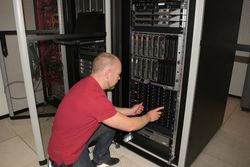A Brief Guide to Firewalls

Strong commercial network security is a must for protecting customer data, proprietary information, and financial accounts. Most businesses rely on firewalls to protect their networks. If you’re unfamiliar with these tools, the guide below covers all you need to know to secure your database.
What Is a Firewall?
A firewall is designed to prevent unauthorized connections to a company’s internal network. It allows only authorized team members to access the central files and programs that they need to perform their jobs.
 Depending on the type of network your company uses, a firewall can come in the form of hardware or software. For example, an onsite setup may include a hardware firewall to cover all workstations, while employees who work remotely may use software-based protection. Most companies require several types of firewalls to cover all bases.
Depending on the type of network your company uses, a firewall can come in the form of hardware or software. For example, an onsite setup may include a hardware firewall to cover all workstations, while employees who work remotely may use software-based protection. Most companies require several types of firewalls to cover all bases.
Why Should Your Business Have Firewalls?
These systems help prevent cyberattacks, safeguarding proprietary data and personal information. They can also prevent malware and viruses from infecting workplace devices, preventing inconvenient malfunctions and data loss.
You can also use firewalls to ensure employees remain in compliance with policies on network usage. For example, you restrict access to unapproved websites and block messages that send sensitive data outside of the organization. You can also view reports about internet usage to gain insights about employee productivity, allowing you to ultimately make positive changes that support your operations.
If you’re interested in installing network security solutions, contact Concord Technology Group. Serving small- to medium-sized businesses throughout the Greater Cleveland area, OH, the company provides a wide array of managed IT solutions. The team customizes products to the needs of each client, so you can get the exact level of support your organization needs. Visit their website to see a full list of network services, or call (440) 210-3200 to discuss network security with an expert.
About the Business
Have a question? Ask the experts!
Send your question

